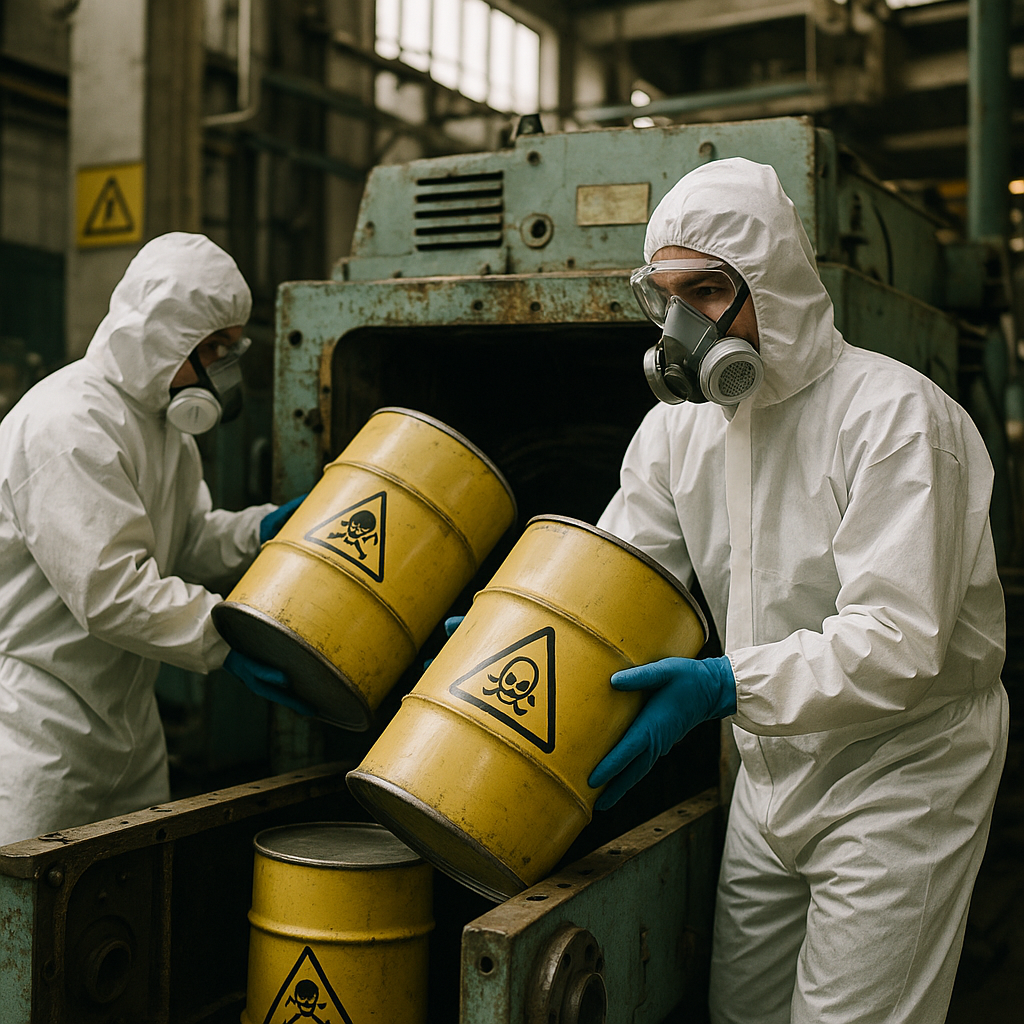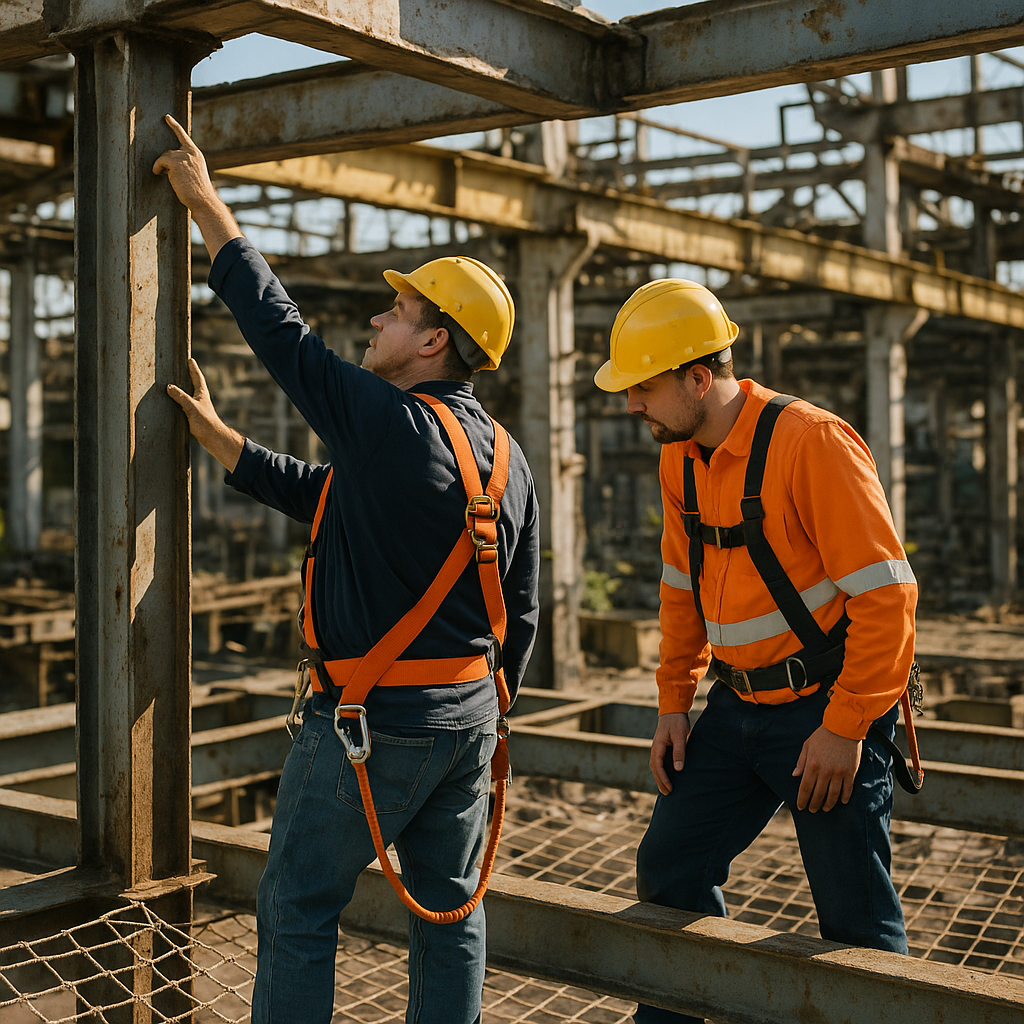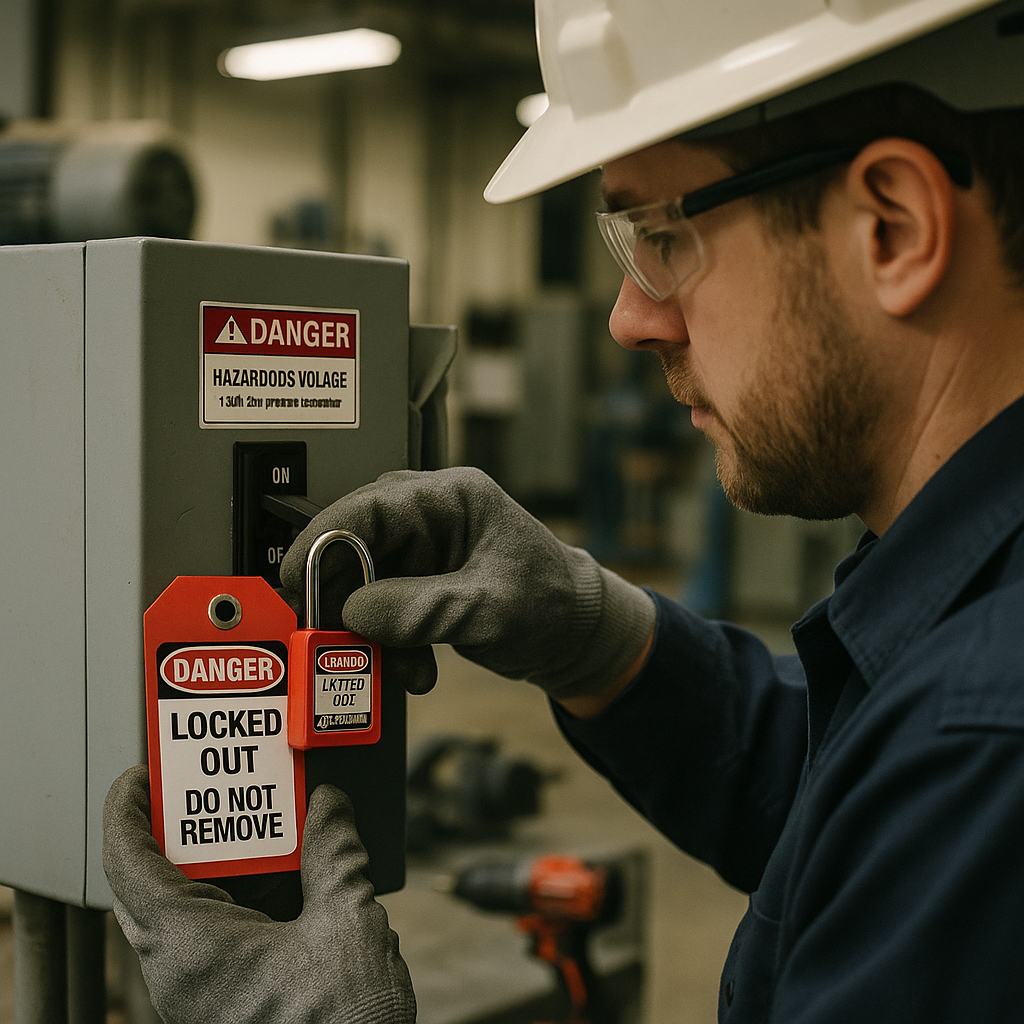5901 Botham Jean Blvd, Dallas, TX 75215
OSHA Regulations for Dismantling Industrial Machinery
August 2, 2025When industrial machinery reaches the end of its lifecycle, proper dismantling is crucial for ensuring worker safety and environmental protection. The Occupational Safety and Health Administration (OSHA) provides comprehensive regulations to guide this process, preventing workplace accidents and injuries.
Dismantling industrial machinery involves significant hazards, such as falling debris, unexpected energy release, and exposure to hazardous materials. OSHA’s stringent regulations exist because dismantling operations account for numerous workplace injuries each year when proper protocols are not followed.
These regulations establish a framework to protect workers and ensure responsible material recovery. We will explore the specific requirements companies must follow when dismantling industrial equipment.
How Should Hazardous Materials be Handled During Machinery Dismantling?

When dismantling industrial machinery, proper handling of hazardous materials is not just a regulatory requirement—it’s a critical safety measure that protects workers, communities, and the environment. Industrial equipment often contains dangerous substances that require specialized management techniques during the decommissioning process.
Identifying hazardous materials must occur before any dismantling work begins. Common hazardous substances found in industrial machinery include asbestos in insulation, lead-based paint on older equipment, PCBs in electrical components, mercury in switches, and various industrial chemicals or oils that may contain toxic compounds.
OSHA Compliance Requirements
The Occupational Safety and Health Administration (OSHA) mandates a thorough pre-demolition assessment to identify all hazardous materials present. This includes implementing proper isolation procedures through lockout/tagout protocols to prevent accidental energy release during the dismantling process. OSHA regulation 29 CFR 1910.147 specifically addresses the control of hazardous energy during machinery dismantling.
Key OSHA requirements include:
- Conducting comprehensive site assessments before work begins
- Developing detailed hazardous material management plans
- Ensuring all workers have proper training and certification
- Implementing strict containment strategies to prevent contamination
- Using appropriate personal protective equipment (PPE)
Safe Handling Procedures
Once hazardous materials are identified, specialized handling procedures must be followed. Typically, this involves engaging certified professionals with specific training in hazardous material removal. These specialists understand the unique characteristics of each substance and the safest methods for containment and removal.
Effective containment measures are essential to prevent hazardous materials from becoming airborne or contaminating surrounding areas. This includes setting up containment barriers with negative air pressure systems, using water misting for dust suppression, and employing specialized tools designed for hazardous material handling.
For asbestos removal, workers must use respirators with HEPA filters, disposable coveralls, gloves, and eye protection. Work areas must be sealed with plastic sheeting to create negative pressure zones that prevent fiber release into clean spaces.
Proper Disposal Protocols
Disposal of hazardous materials must follow strict environmental regulations. Each type of hazardous material has specific disposal requirements that must be followed to prevent environmental contamination.
Materials must be properly labeled, packaged in approved containers, and transported only to licensed disposal facilities designated for handling the particular type of hazardous waste. Comprehensive documentation of the disposal process is essential for regulatory compliance and future liability protection.
Water and soil testing may be required following machinery dismantling to ensure no environmental contamination has occurred. If contamination is detected, additional remediation steps will be necessary.
Case Study: Safe Dismantling of Manufacturing Equipment
A recent project involving a roofing material manufacturer demonstrates best practices in hazardous material handling during equipment decommissioning. The manufacturer needed to dismantle obsolete manufacturing equipment containing multiple hazardous components.
The environmental services company conducting the work first performed a thorough assessment to identify all hazardous materials present. They then developed a comprehensive safety plan that included:
- Establishing containment zones around the equipment
- Implementing a detailed lockout/tagout program
- Providing specialized PPE to all workers
- Setting up air monitoring systems to detect any release of hazardous substances
Certified professionals with specific training in hazardous materials removal safely dismantled the equipment. Hazardous components were meticulously packaged using appropriate materials to ensure safe transport. The team coordinated proper transportation and disposal of all hazardous materials, adhering to all relevant regulations.
This methodical approach ensured the project was completed safely, with no worker injuries or environmental contamination. The client maintained full regulatory compliance throughout the process, avoiding potential fines and liabilities.
Decontamination Processes
After hazardous material removal, thorough decontamination of the work area is essential. This includes cleaning all surfaces, disposing of contaminated materials properly, and verifying that no hazardous residues remain. Air quality testing confirms that the area is safe for general work to continue.
Equipment used in the dismantling process must also be properly decontaminated before it leaves the work site to prevent cross-contamination. Workers must follow specific decontamination procedures before removing their protective equipment to prevent personal exposure.
Through proper identification, safe handling, compliant disposal, and thorough decontamination, hazardous materials can be safely managed during industrial machinery dismantling. This comprehensive approach protects human health and the environment while ensuring regulatory compliance.
What are the Requirements for Fall Protection and Structural Stability?

When dismantling elevated machinery or structures, OSHA regulations mandate comprehensive fall protection measures to prevent worker injuries. These regulations are crucial as dismantling operations inherently create changing work environments with evolving hazards.
OSHA standard 29 CFR 1926 Subpart M outlines mandatory fall protection requirements. When workers face fall hazards of 6 feet or more, employers must provide protection through one or more of these systems: personal fall arrest systems (PFAS), guardrail systems, or safety net systems. For dismantling operations, PFAS often provides the most adaptable solution as fixed guardrails may be impractical during progressive dismantling.
Personal fall arrest systems must include three essential components: an anchor point capable of supporting 5,000 pounds per attached worker, a connecting device like a lanyard with shock absorption capabilities, and a full-body harness that distributes fall forces across the worker’s body. These systems require inspection before each use to verify integrity.
Structural stability presents equally critical concerns during dismantling. OSHA standard 1926.850(a) requires a competent person to conduct an engineering survey before beginning any demolition or dismantling work. This survey must assess the condition of framing, floors, and walls, identifying potential unplanned collapse risks. The employer must maintain written evidence that this survey was performed.
Throughout dismantling operations, temporary bracing or shoring may be necessary to maintain structural integrity. According to 1926.854(b), no wall section exceeding one story in height should stand without lateral bracing unless it was originally designed to be self-supporting. All temporary supports must be calculated to handle anticipated loads, including dynamic forces created during component removal.
When removing pins or connection points during dismantling, workers must follow specific protocols to maintain stability. As outlined in 1926.1404(h)(7), boom sections, suspension systems, and components must be rigged or supported to maintain stability upon pin removal. This often requires sequential disassembly plans to prevent the sudden release of stored energy.
A designated competent person must continuously monitor the structure during dismantling. This individual must possess both the knowledge to identify hazards and the authority to implement immediate corrective actions. According to OSHA standard 1926.859(g), inspections must continue throughout the dismantling process to detect hazards from weakened structures or loosened materials.
The changing center of gravity during component removal is another critical stability consideration. As heavy machinery components are removed, the weight distribution of the remaining structure changes, potentially creating unexpected tipping or collapse hazards. Proper planning must account for these shifting load paths.
All dismantling operations should establish clear communication protocols and emergency response procedures. Workers should be trained to recognize warning signs of potential structural failure, including unusual noises, sudden settling, or visible deformation of supporting members.
By implementing these comprehensive fall protection and structural stability measures, employers can significantly reduce the risks associated with machinery dismantling operations while maintaining compliance with OSHA requirements.
How Should Power Sources and Energy Control be Managed?

Proper management of power sources and energy control is essential for safe machinery dismantling. Without adequate controls, stored energy can release unexpectedly, leading to serious injuries or fatalities. OSHA’s standard for Control of Hazardous Energy (1910.147) provides clear guidelines for protecting workers during these operations.
When dismantling machinery, it’s crucial to identify and control all potential energy sources, such as electrical circuits, hydraulic systems, pneumatic pressure, mechanical components, and gravity-influenced parts that could fall or shift. Each energy type presents unique hazards that require specific isolation techniques.
Developing an Energy Control Program
A comprehensive written energy control program is the cornerstone of safe dismantling operations. This program must include energy control procedures, employee training protocols, and periodic inspection requirements. The procedures should detail steps for shutting down, isolating, blocking, and securing machinery.
Your energy control program should cover key elements such as:
- Clear identification of all energy sources in machinery
- Specific procedures for isolating each energy type
- Methods for verifying that energy isolation has been achieved
- Rules for placing, removing, and transferring lockout devices
- Requirements for testing machinery during dismantling
Remember, these procedures must be machine-specific. Generic procedures rarely provide adequate protection.
The Lockout/Tagout Process
The lockout/tagout process involves six essential steps that must be followed in sequence:
1. Preparation: Authorized employees must understand the types of energy involved, their hazards, and appropriate control methods before starting.
2. Machine Shutdown: Turn off machinery using established procedures and notify all affected employees about the shutdown.
3. Energy Isolation: Physically disconnect or separate the machinery from every energy source. This might involve turning off circuit breakers, closing valves, or installing blocks.
4. Application of Lockout Devices: Place locks on energy-isolating devices to keep them in the “safe” position. Each authorized employee should apply their own personal lock.
5. Control Stored Energy: Release, disconnect, or restrain any hazardous stored energy. This may involve releasing pressure, draining fluids, or blocking moving parts.
6. Verification: Test machinery controls and ensure all energy sources are effectively isolated before beginning dismantling work.
Only authorized employees with proper training should perform lockout/tagout operations during each phase.
Authorized vs. Affected Employees
OSHA distinguishes between authorized and affected employees in lockout/tagout operations:
- Authorized employees are trained to recognize hazardous energy sources and apply energy control procedures and are the only ones who may perform lockout/tagout operations.
- Affected employees operate or use machinery being serviced or work nearby. They must understand the purpose of energy control and not attempt to restart locked-out equipment.
This distinction ensures only properly trained personnel handle critical safety tasks.
The Dangers of Improper Energy Control
Real-world accidents highlight the severe consequences of inadequate energy control. For instance, a maintenance worker was crushed while repairing a conveyor system because a coworker restarted the machinery, unaware maintenance was ongoing. Proper lockout procedures would have prevented this tragedy.
In another incident, a worker was severely injured when hydraulic pressure was released unexpectedly during equipment dismantling. The team had secured electrical power but failed to release stored hydraulic energy.
These examples underscore why comprehensive energy control procedures must address all energy types and why only authorized employees should perform these critical tasks.
When developing and implementing energy control procedures, remember that even minor oversights can have serious consequences. Take the time to identify all energy sources, establish clear procedures, and ensure all team members understand their roles in maintaining safety.
Conclusion: Ensuring Compliance and Safety in Industrial Machinery Dismantling
OSHA compliance during industrial machinery dismantling is not just about following rules; it’s about protecting lives, preventing injuries, and creating a safe working environment for everyone involved. Companies that prioritize these safety measures avoid costly penalties and demonstrate a commitment to their workers’ well-being.
The key to successful dismantling operations lies in thorough preparation and strict adherence to established protocols. Engineering surveys should be completed before work begins. Hazardous materials need proper identification, handling, and disposal. Fall protection systems must be in place wherever workers face height risks. Structural stability should be continuously monitored throughout the dismantling process. Most importantly, proper lockout/tagout procedures must be implemented to control dangerous energy sources.
By adhering to these guidelines and fostering a strong safety culture, organizations can significantly reduce risks while maintaining efficient operations. Remember, safety is not an afterthought but the foundation upon which successful dismantling projects are built.
Is your company planning an industrial dismantling project? Ensure your team is fully prepared to handle the complex challenges ahead. For expert assistance with your recycling needs during machinery dismantling, contact Okon Recycling at 214-717-4083.
